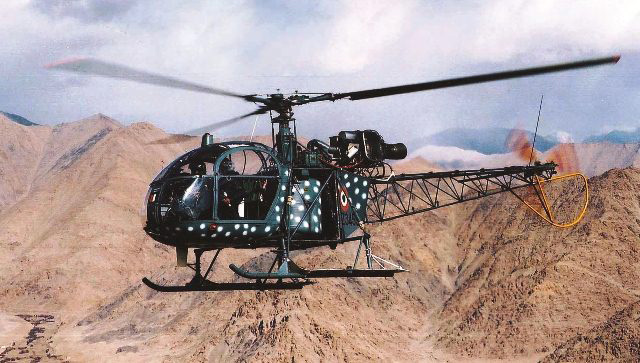‘Siachen Pioneers’ bets on Cheetal helicopters as replacement to ageing Cheetah
August 16, 2016
By Snehesh Alex Philip
Siachen Glacier: IAF’s iconic unit ‘Siachen Pioneers’, which is a lifeline for thousands of soldiers posted in the arduous and world’s highest battlefield, wants to replace ageing Cheetah choppers with the Cheetals that come equipped with modern engine.
114 Helicopter Unit, also known as Siachen Pioneers, is the mainstay of the soldiers who are posted even at the height of 22,000 feet, as they carry essential food and equipment to various posts in the Siachen Glacier.
The highly decorated unit currently operates 14 helicopters of which 10 are Cheetal and four are Cheetah, first made available in the 1970s.
Cheetal is the re-engined version of the Cheetah helicopter and comes equipped with French-origin Turbomeca engine which also powers the Advanced Light Helicopter Dhruv.
The project initiated during 2002 was aimed at enhancing high altitude operational capabilities and maintainability as well as to provide a mid-life upgrade for safe and reliable operations.
“We are very happy with the performance of the Cheetals.
They are not only more powerful than the Cheetah but also fuel efficient which means that a little bit more load can be carried on them,” Wing Commander S Ramesh, Commanding Officer of the of the 114 ‘Siachen Pioneers’, told PTI.
He added that the Unit is looking at replacing the four Cheetah helicopters it has with the Cheetal.
Everyday, the ‘Siachen Pioneers’ carries out numerous sorties to Siachen glacier braving inclement weather conditions including high speed icy winds. The squadron is tasked from Kargil to eastern Ladakh.
And all this comes at a cost. The unit, which is perhaps the only in the world to be deployed in action continuously for over three decades because of “Operation Meghdoot”, has lost 13 officers till now.
The work routinely involves landing at the highest helipads in the world in Siachen glacier and flying the helicopters to the edge of its flight envelope over a very treacherous terrain marked by uncertain weather.
The unit has also found a place in the Limca Book for World Records for the highest helicopter landing at a density altitude of 25,140 feet.
Besides this, the Unit is well-known for its daring rescue of mountaineers and trekkers from across the globe year after year.
It regularly undertakes flights to assist locals who live in the remote regions of Leh and Ladakh area.
This includes ensuring that the students and teachers are airlifted in IAF helicopter to reach their schools at Leh and back home.
Earlier, the dangerous ‘Chaddar’ trek over the frozen Zanskar river was the only way for children and teachers of the area to reach Leh.
Another team of the IAF, 153 Helicopter Unit (Daring Dragons), which flies Mi 17 V5 also assists the soldiers since they carry higher load of men, ration and equipment.
Asked how he would describe his unit, Wing Commander Ramesh showed the book ‘Soldier Mountaineer’ written by Colonel Narinder ‘Bull’ Kumar, highly-decorated officer of the Kumaon Regiment who planted the Indian flag on the Siachen Glacier in 1981.
“To CO, 114 Helicopter Sqn – Lifeline of the Siachen Glacier Garrison,” read the personally signed note of Kumar.
In the summer of 1984, the Indian army launched its first major offensive against the Pakistani army at Siachen and established bases along the glacier. Their main weapon was the detailed maps, plans, photographs made by Kumar and his team.
PTI
Recent Stories
- Scooterist dies after being hit by AMTS bus; driver held
- Renovated war memorial 'Shraddhanjali Park' unveiled at Bhuj Military Station
- Strand Life Sciences Develops Prenatal Genomic Diagnostics Portfolio
- 265 candidates in fray for 25 Lok Sabha seats in Gujarat
- Mob attacks Hindu couple, attempts shop arson in Ochchan village
- Nilesh Kumbhani leaves Surat for vacation with family
- Power demand in Gujarat crosses 23,000 MW mark
